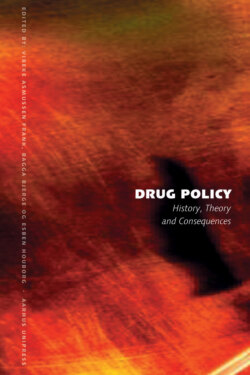Читать книгу Drug Policy - Группа авторов - Страница 8
Harm reduction
ОглавлениеThe first real introduction of harm-reduction thinking in Danish drug policy occurred in the mid-1980s, when the principle of working towards ‘graduated goals’, as mentioned above, was introduced. This was a major policy change from a treatment policy, which had until then made abstinence the primary priority. This policy change towards providing treatment and help, even to people who continued to use drugs, was stressed even further in the following years, when prevention of AIDS became a major concern for Danish drug policy. This shift in thinking about treatment was a major factor behind the development and (for a long time ambivalent) acceptance of methadone maintenance treatment in Denmark (Houborg 2006). The AIDS problem led to the introduction of syringe exchange programmes in Denmark, albeit with large local differences. From the early 1990s social exclusion became a major concern in Danish social policy, and as a consequence large resources were allocated to develop new measures and services for socially excluded people, among them drug users (Narkotikarådet 1999; Bømler 2000). Accordingly, many low-threshold institutions as mentioned above were established.
Denmark has been more reticent with regard to more controversial harm-reduction measures. The white paper called The Fight against Drugs (Regeringen 2003), which articulates current Danish drug policy, argues that new measures in Danish drug policy should always be judged not only by the extent to which they help the people they target, but also according to how they affect the way we live with drugs in Denmark more generally. More specifically, steps should be measured according to how they affect the prohibition of all non-medical and non-scientific use of narcotic drugs, which has been the basis of Danish drug policy since the Act on Euphoriant Drugs in 1955, but underlined by the signing of the United Nations 1961 Single Convention on Narcotic Drugs (see below). This means that even if there is evidence that a measure helps the people it targets, it should only be implemented if it does not violate this basic principle of Danish drug policy, which it might do by ‘sending the wrong signal’ that drug use is acceptable, for instance. According to The Fight against Drugs, evidence about the effects of specific measures should always be subjected to the political discussion about how we want to live with drugs. Ever since the birth of modern Danish drug policy in 1955, the political majority has been in favour of a use-reduction drug policy as the primary goal of Danish drug policy, instead of a drug policy which has harm reduction as its primary goal.
On this basis The Fight against Drugs rejected both heroin maintenance treatment and safe-injection facilities, although to some extent this was done on different grounds. Heroin maintenance was largely rejected on pragmatic grounds: it was too expensive, and it was not appropriate to implement a controversial measure as long as the existing measures were not used to the maximum extent. It was acknowledged that heroin treatment might not constitute a formal violation of the conventions, because it would be defined as medical treatment. But it was felt that it would send a mixed signal about heroin as an illegal drug. This pragmatic rejection of heroin treatment made it relatively easy for the government to change its position when a majority emerged in the Danish Parliament in 2007 in favour of heroin treatment. Thus, on the state budget for 2008 and 2009 roughly EUR 10 million has been allocated to an experiment with heroin treatment. Safe-injection facilities have been rejected on more formal grounds, because they were seen as a direct violation of the prohibition against the non-medical and non-scientific use of illegal drugs. According to The Fight against Drugs, safe-injection facilities would violate not only the foundations of Danish drug policy (both formal and ideological), but also the international drug control treaties, which Denmark has signed.
